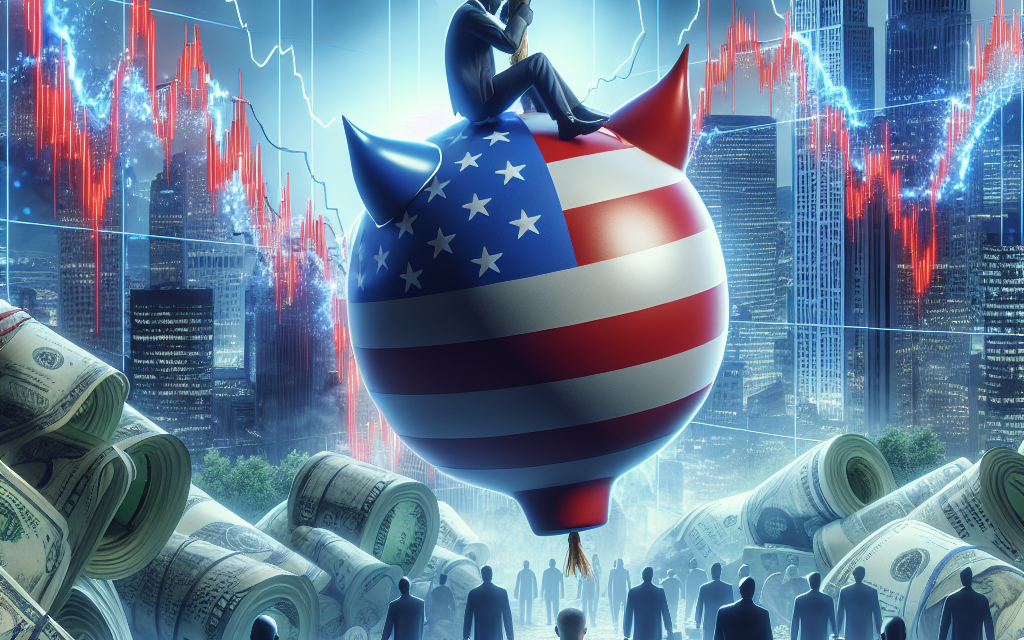“Market Momentum Meets Resistance: Navigating the Trump-Driven Stock Surge”
Introduction
In recent years, the U.S. stock market has experienced significant volatility, driven in part by the policies and rhetoric of former President Donald Trump. While his administration’s tax cuts and deregulation efforts initially fueled a surge in stock prices, several challenges have since emerged, stalling this momentum. These challenges include geopolitical tensions, trade wars, and domestic policy uncertainties, which have introduced a level of unpredictability that has made investors cautious. Additionally, concerns over economic fundamentals, such as corporate earnings growth and rising interest rates, have further complicated the market landscape. As a result, the initial optimism that characterized the Trump-driven stock surge has been tempered by a more complex and uncertain economic environment, prompting investors to reassess their strategies in navigating these turbulent times.
Economic Uncertainty Amid Political Tensions
The recent surge in U.S. stocks, largely driven by policies and rhetoric from former President Donald Trump, has encountered significant challenges, leading to a period of economic uncertainty amid ongoing political tensions. This development has left investors and analysts grappling with the implications for the broader economy. Initially, the Trump administration’s focus on deregulation, tax cuts, and a pro-business agenda fueled optimism in the financial markets. These measures were perceived as catalysts for economic growth, prompting a bullish sentiment among investors. However, as the political landscape has evolved, so too have the factors influencing market dynamics.
One of the primary challenges facing the stock market is the heightened political tension that has persisted even after Trump’s presidency. The polarization within the U.S. political system has created an environment of unpredictability, which is often detrimental to investor confidence. Political disagreements over fiscal policies, trade relations, and regulatory frameworks have introduced a level of uncertainty that complicates market forecasts. Moreover, the potential for abrupt policy shifts or legislative gridlock further exacerbates these concerns, making it difficult for businesses to plan for the future.
In addition to political factors, economic indicators have also contributed to the current state of uncertainty. Inflationary pressures, for instance, have become a focal point for both policymakers and investors. Rising consumer prices, driven by supply chain disruptions and increased demand, have sparked fears of an overheating economy. The Federal Reserve’s response to these inflationary trends, including potential interest rate hikes, adds another layer of complexity to the economic outlook. Investors are keenly aware that changes in monetary policy can have profound effects on asset valuations and market stability.
Furthermore, the global economic environment plays a crucial role in shaping the trajectory of U.S. stocks. International trade tensions, particularly with major economies such as China, have resurfaced as a significant concern. The imposition of tariffs and the threat of trade wars can disrupt global supply chains and hinder economic growth. As a result, multinational corporations face increased risks, which can translate into volatility in the stock market. Additionally, geopolitical events, such as conflicts or diplomatic disputes, have the potential to trigger sudden market reactions, further complicating the investment landscape.
Despite these challenges, it is important to recognize that the U.S. economy remains resilient. The labor market has shown signs of strength, with unemployment rates gradually declining and job creation continuing at a steady pace. Consumer spending, a key driver of economic growth, has also demonstrated robustness, supported by government stimulus measures and pent-up demand. These positive indicators provide a counterbalance to the prevailing uncertainties, offering a glimmer of hope for investors seeking stability.
In conclusion, the Trump-driven surge in U.S. stocks has encountered a series of obstacles that have introduced economic uncertainty amid political tensions. The interplay between political dynamics, economic indicators, and global factors creates a complex environment for investors to navigate. While challenges persist, the resilience of the U.S. economy offers a degree of optimism. As market participants continue to assess the evolving landscape, the ability to adapt to changing conditions will be crucial in determining the future trajectory of U.S. stocks.
Trade Policy Reversals Impacting Market Confidence
The recent surge in U.S. stocks, largely driven by policies and rhetoric from former President Donald Trump, has encountered significant challenges, primarily due to trade policy reversals that are impacting market confidence. Initially, Trump’s administration was characterized by a pro-business stance, tax cuts, and deregulation, which collectively contributed to a bullish stock market. Investors were buoyed by the promise of economic growth and increased corporate profitability. However, the landscape has shifted considerably, with trade policy reversals emerging as a critical factor influencing market dynamics.
One of the most significant changes has been the shift in trade policies under the current administration. The previous administration’s approach was marked by aggressive trade negotiations and tariffs, particularly targeting China. These measures were intended to protect American industries and reduce trade deficits. While they initially created volatility, they also led to a sense of predictability as markets adjusted to the new normal. However, the current administration has taken steps to reverse some of these policies, seeking to mend trade relations and reduce tariffs. While this approach aims to foster international cooperation and stabilize global trade, it has introduced a new layer of uncertainty for investors.
The reversal of trade policies has led to mixed reactions in the market. On one hand, some investors welcome the potential for improved international relations and the reduction of trade barriers, which could lead to increased global trade and economic growth. On the other hand, the abrupt changes have left many market participants uncertain about the future direction of U.S. trade policy. This uncertainty is compounded by ongoing geopolitical tensions and the complexities of renegotiating trade agreements, which can have far-reaching implications for multinational corporations and domestic industries alike.
Moreover, the impact of these trade policy reversals is not limited to the stock market. They also have significant implications for the broader economy. For instance, industries that were previously protected by tariffs may now face increased competition from foreign imports, potentially affecting their profitability and market share. Conversely, industries that rely on exports may benefit from improved access to international markets. This dual impact creates a complex environment for investors, who must navigate these changes while assessing the potential risks and opportunities.
In addition to trade policy reversals, other factors are contributing to the challenges facing the stock market. Inflationary pressures, supply chain disruptions, and labor market dynamics are all playing a role in shaping investor sentiment. These factors, combined with the uncertainty surrounding trade policies, have led to increased market volatility. Investors are now tasked with balancing short-term market fluctuations with long-term investment strategies, a challenge that requires careful analysis and a keen understanding of the evolving economic landscape.
In conclusion, the Trump-driven surge in U.S. stocks is facing significant headwinds due to trade policy reversals and other economic factors. While the potential for improved international relations and reduced trade barriers offers opportunities, the uncertainty surrounding these changes is impacting market confidence. As investors navigate this complex environment, they must remain vigilant and adaptable, considering both the risks and opportunities that lie ahead. The evolving nature of trade policies and their broader economic implications will continue to be a critical factor influencing the trajectory of U.S. stocks in the coming months.
Regulatory Changes Affecting Key Industries
The recent surge in U.S. stocks, largely driven by policies and rhetoric from former President Donald Trump, has encountered significant challenges, particularly due to regulatory changes affecting key industries. These changes have introduced a layer of uncertainty that has tempered investor enthusiasm and prompted a reevaluation of market dynamics. As the regulatory landscape evolves, industries such as technology, finance, and energy are experiencing shifts that could have long-term implications for their growth trajectories.
To begin with, the technology sector, which has been a major driver of stock market gains, is facing increased scrutiny from regulators. Antitrust investigations and privacy concerns have led to calls for stricter regulations on major tech companies. This has created an environment of uncertainty, as investors grapple with the potential impact of regulatory actions on the profitability and operational flexibility of these firms. The prospect of increased regulation has led to volatility in tech stocks, as market participants weigh the benefits of innovation against the risks of regulatory intervention.
Similarly, the financial sector is navigating a complex regulatory environment. The rollback of certain financial regulations during the Trump administration had initially spurred optimism among investors, leading to a rally in bank stocks. However, recent discussions about reinstating some of these regulations have introduced a degree of caution. The potential for increased oversight and compliance costs could affect the profitability of financial institutions, thereby influencing their stock performance. As policymakers debate the appropriate level of regulation, financial markets remain on edge, with investors closely monitoring developments that could impact the sector’s future.
In the energy sector, regulatory changes are also playing a pivotal role. The Trump administration’s policies had favored deregulation, particularly in the fossil fuel industry, which led to a boost in energy stocks. However, the current administration’s focus on environmental sustainability and clean energy initiatives has shifted the regulatory focus. This shift has created challenges for traditional energy companies, as they face stricter environmental regulations and increased competition from renewable energy sources. The transition towards a more sustainable energy landscape is reshaping the industry’s dynamics, prompting investors to reassess their strategies and consider the long-term viability of their investments.
Moreover, the healthcare industry is not immune to the effects of regulatory changes. The ongoing debate over healthcare reform and drug pricing has introduced uncertainty into the sector. Pharmaceutical companies, in particular, are facing pressure to justify their pricing strategies, which could lead to regulatory actions aimed at controlling costs. This has implications for the profitability of these companies and, by extension, their stock performance. As the regulatory environment continues to evolve, healthcare investors are closely watching policy developments that could impact the industry’s financial outlook.
In conclusion, while the Trump-driven surge in U.S. stocks initially brought optimism to the markets, the subsequent regulatory changes across key industries have introduced challenges that cannot be overlooked. The evolving regulatory landscape is reshaping the investment environment, prompting investors to navigate a complex web of risks and opportunities. As industries adapt to these changes, the stock market’s trajectory will likely be influenced by how effectively companies can manage regulatory pressures while continuing to drive innovation and growth. Consequently, investors must remain vigilant, staying informed about regulatory developments and their potential impact on market dynamics.
Inflation Concerns and Interest Rate Hikes

The recent surge in U.S. stocks, largely driven by policies and economic optimism during the Trump administration, has encountered significant challenges, primarily due to rising inflation concerns and subsequent interest rate hikes. As investors navigate this complex landscape, the interplay between inflationary pressures and monetary policy decisions has become a focal point of market analysis. Understanding these dynamics is crucial for stakeholders aiming to anticipate future market movements and make informed investment decisions.
Inflation, a persistent increase in the price level of goods and services, has emerged as a formidable challenge to the stock market’s upward trajectory. Several factors have contributed to this inflationary environment, including supply chain disruptions, increased consumer demand, and expansive fiscal policies. As the economy recovers from the pandemic-induced downturn, pent-up demand has surged, outpacing supply and leading to price increases across various sectors. This imbalance has raised concerns among investors and policymakers alike, as sustained inflation can erode purchasing power and destabilize economic growth.
In response to these inflationary pressures, the Federal Reserve has signaled a shift in its monetary policy stance, moving away from the accommodative measures that characterized the early stages of the economic recovery. Interest rate hikes, a primary tool used by central banks to combat inflation, have been introduced to temper economic overheating and stabilize prices. However, these rate increases have also introduced new challenges for the stock market. Higher interest rates can lead to increased borrowing costs for businesses, potentially dampening corporate profits and investment. Additionally, they can make fixed-income investments more attractive relative to equities, prompting a reallocation of assets that could exert downward pressure on stock prices.
The relationship between inflation, interest rates, and stock market performance is complex and multifaceted. While moderate inflation can be indicative of a growing economy, excessive inflation can undermine economic stability and investor confidence. The Federal Reserve’s challenge lies in striking a delicate balance between curbing inflation and supporting economic growth. This balancing act is further complicated by external factors such as geopolitical tensions and global economic conditions, which can influence both inflationary trends and monetary policy decisions.
Moreover, the impact of interest rate hikes on different sectors of the stock market is not uniform. Sectors such as technology, which are often characterized by high growth potential and reliance on future earnings, may be more sensitive to rising interest rates. Conversely, sectors like financials may benefit from higher rates, as they can lead to improved profit margins for banks and other financial institutions. Investors must therefore adopt a nuanced approach, considering sector-specific dynamics and broader economic indicators when making investment decisions.
In conclusion, the Trump-driven surge in U.S. stocks faces significant headwinds from inflation concerns and interest rate hikes. As the Federal Reserve navigates the complex task of managing inflation without stifling economic growth, investors must remain vigilant and adaptable. By closely monitoring economic indicators and understanding the implications of monetary policy shifts, stakeholders can better position themselves to navigate the challenges and opportunities that lie ahead in the evolving financial landscape.
Geopolitical Risks and Their Market Implications
The recent surge in U.S. stocks, largely driven by policies and rhetoric from former President Donald Trump, has encountered significant challenges, primarily due to escalating geopolitical risks. These risks, which have become increasingly pronounced, are exerting pressure on the market, creating a complex landscape for investors to navigate. As the global political climate becomes more volatile, the implications for financial markets are profound, necessitating a closer examination of the factors at play.
To begin with, the geopolitical tensions between major world powers have intensified, casting a shadow over the optimistic market sentiment that characterized the Trump era. The trade policies and international relations strategies implemented during Trump’s presidency initially fueled a bullish market, as investors anticipated economic growth and deregulation. However, the long-term effects of these policies are now being scrutinized, particularly as relations with key trading partners become strained. The ongoing trade disputes, especially with China, have introduced a level of uncertainty that is unsettling for investors who thrive on predictability and stability.
Moreover, the geopolitical landscape is further complicated by regional conflicts and political instability in various parts of the world. The Middle East, for instance, remains a hotbed of tension, with conflicts that have the potential to disrupt global oil supplies and, consequently, impact energy prices. Such disruptions can lead to increased volatility in the stock market, as investors react to the fluctuating prices of commodities that are integral to the global economy. Additionally, the situation in Eastern Europe, particularly the tensions involving Russia and Ukraine, poses a significant risk to market stability. The potential for sanctions and countermeasures can have far-reaching effects on international trade and investment flows.
In addition to these regional issues, the rise of populism and nationalism in various countries presents another layer of complexity. These political movements often advocate for protectionist policies, which can hinder international trade and economic cooperation. As countries become more insular, the global market faces the risk of fragmentation, which can lead to reduced economic growth and increased market volatility. Investors must therefore remain vigilant, as shifts in political ideologies can have immediate and long-term consequences for their portfolios.
Furthermore, the impact of these geopolitical risks is not confined to traditional markets alone. The rise of digital currencies and the increasing importance of technology in the financial sector introduce new vulnerabilities. Cybersecurity threats, for instance, are a growing concern, as state-sponsored attacks and hacking incidents can undermine investor confidence and disrupt financial systems. The interconnectedness of global markets means that a cyberattack in one region can have ripple effects worldwide, further complicating the investment landscape.
In conclusion, while the Trump-driven surge in U.S. stocks initially brought about a period of growth and optimism, the current geopolitical risks present formidable challenges that cannot be ignored. Investors must navigate a world where political tensions, regional conflicts, and emerging threats like cybersecurity are ever-present. As these factors continue to evolve, the implications for financial markets are significant, requiring a strategic and informed approach to investment. By understanding the intricate web of geopolitical risks, investors can better position themselves to mitigate potential losses and capitalize on opportunities that may arise in this uncertain environment.
Shifts in Consumer Spending Patterns
The recent surge in U.S. stocks, largely driven by policies and economic optimism associated with former President Donald Trump, has encountered significant challenges, particularly as shifts in consumer spending patterns begin to reshape the economic landscape. While the initial boost in the stock market was fueled by tax cuts, deregulation, and a pro-business stance, the evolving behavior of consumers is now presenting a complex set of hurdles that investors and policymakers must navigate.
To begin with, the pandemic has fundamentally altered how consumers allocate their resources, leading to a shift from goods to services. During the height of the pandemic, there was a marked increase in spending on goods, as consumers stocked up on essentials and invested in home improvements. However, as restrictions have eased, there has been a noticeable pivot towards services such as travel, dining, and entertainment. This transition has created a ripple effect across various sectors, impacting companies that thrived during the goods boom and challenging them to adapt to the new consumer preferences.
Moreover, the rise of e-commerce and digital platforms has accelerated, further influencing spending habits. Consumers are increasingly favoring online shopping, which has pressured traditional brick-and-mortar retailers to innovate or face obsolescence. This shift has also led to increased competition among e-commerce giants, driving them to enhance their logistics and customer service capabilities. Consequently, companies that fail to embrace digital transformation may find themselves at a disadvantage, struggling to capture the attention and wallets of tech-savvy consumers.
In addition to these shifts, inflationary pressures have begun to weigh heavily on consumer spending. Rising prices for essential goods and services have eroded purchasing power, forcing consumers to prioritize their expenditures. This has resulted in a more cautious approach to spending, with many opting to save rather than splurge. The Federal Reserve’s response to inflation, through interest rate adjustments, further complicates the economic environment, as higher borrowing costs can dampen consumer enthusiasm and slow economic growth.
Furthermore, demographic changes are playing a crucial role in shaping spending patterns. The aging population, coupled with the financial priorities of younger generations, is influencing how money is spent across different sectors. Older consumers tend to focus on healthcare and retirement savings, while younger individuals prioritize experiences and technology. This divergence in spending priorities necessitates a strategic reevaluation by businesses aiming to capture diverse market segments.
Additionally, environmental and social considerations are increasingly influencing consumer choices. There is a growing demand for sustainable and ethically produced goods, prompting companies to adopt more transparent and responsible practices. This shift towards conscious consumerism is not only reshaping product offerings but also impacting brand loyalty and reputation.
In conclusion, while the Trump-driven surge in U.S. stocks initially brought optimism and growth, the current shifts in consumer spending patterns present a multifaceted challenge. As consumers continue to redefine their priorities in response to economic, technological, and social changes, businesses and investors must remain agile and forward-thinking. By understanding and adapting to these evolving trends, they can better position themselves to navigate the complexities of the modern economic landscape and sustain growth in an increasingly dynamic market.
Technological Disruptions in Traditional Sectors
The recent surge in U.S. stocks, largely driven by policies and economic optimism during the Trump administration, has encountered significant challenges, particularly as technological disruptions continue to reshape traditional sectors. While the initial boost in investor confidence was fueled by tax cuts and deregulation, the long-term sustainability of this growth is increasingly being questioned. This skepticism is largely due to the rapid pace of technological advancements that are transforming industries such as manufacturing, retail, and finance, which have historically been the backbone of the American economy.
To begin with, the manufacturing sector, once a pillar of U.S. economic strength, is facing unprecedented changes due to automation and artificial intelligence. These technologies promise increased efficiency and reduced costs, yet they also pose a threat to traditional manufacturing jobs. As companies invest in smart factories and robotics, the demand for low-skilled labor diminishes, leading to potential job losses and economic displacement. This shift not only affects employment rates but also has broader implications for consumer spending and economic stability, which are critical components of stock market performance.
Moreover, the retail sector is undergoing a seismic shift as e-commerce giants like Amazon continue to dominate the market. Traditional brick-and-mortar stores are struggling to compete with the convenience and competitive pricing offered by online platforms. This disruption is forcing many established retailers to either adapt by enhancing their digital presence or face the risk of obsolescence. Consequently, the stock performance of these traditional retailers has been volatile, reflecting the uncertainty surrounding their ability to successfully transition in a digital-first world.
In addition to manufacturing and retail, the financial sector is not immune to the waves of technological innovation. Fintech companies are challenging conventional banking models by offering more efficient, user-friendly, and cost-effective services. This competition is compelling traditional banks to invest heavily in technology to retain their customer base and market share. However, the integration of new technologies into existing systems is fraught with challenges, including cybersecurity risks and regulatory compliance issues. These factors contribute to the unpredictability of financial stocks, as investors weigh the potential benefits against the inherent risks.
Furthermore, the energy sector is experiencing its own set of challenges as the world shifts towards renewable energy sources. While the Trump administration’s policies favored fossil fuels, the global trend towards sustainability is undeniable. Technological advancements in solar, wind, and battery storage are making renewable energy more viable and cost-effective. This transition poses a threat to traditional energy companies, which must innovate or risk being left behind. The uncertainty surrounding this transition is reflected in the fluctuating stock prices of energy companies, as investors remain cautious about the sector’s future.
In conclusion, while the Trump-driven surge in U.S. stocks initially brought optimism, the ongoing technological disruptions across traditional sectors present significant challenges. The manufacturing, retail, financial, and energy sectors are all grappling with the need to adapt to a rapidly changing landscape. As these industries navigate the complexities of technological integration, the stock market is likely to experience continued volatility. Investors must remain vigilant, considering both the opportunities and risks that these disruptions entail. Ultimately, the ability of traditional sectors to embrace innovation will play a crucial role in determining the long-term trajectory of U.S. stocks.
Q&A
1. **What are the main challenges affecting the Trump-driven surge in US stocks?**
– Geopolitical tensions, trade uncertainties, and domestic policy shifts.
2. **How have trade uncertainties impacted the stock market?**
– They have led to market volatility and investor caution due to potential tariffs and trade barriers.
3. **What role do geopolitical tensions play in the stock market’s performance?**
– They create uncertainty and risk, leading to potential market instability and affecting investor confidence.
4. **How do domestic policy shifts influence the stock market?**
– Changes in regulations, tax policies, and government spending can directly impact corporate profits and market sentiment.
5. **What sectors are most affected by these challenges?**
– Technology, manufacturing, and agriculture sectors are particularly sensitive to trade and policy changes.
6. **How have investors reacted to these challenges?**
– Many investors have adopted a more cautious approach, diversifying portfolios and seeking safer assets.
7. **What strategies are being employed to mitigate these challenges?**
– Companies and investors are focusing on risk management, strategic planning, and lobbying for favorable policies.
Conclusion
The Trump-driven surge in US stocks faced several challenges that ultimately stalled its momentum. Key factors included geopolitical tensions, trade uncertainties, and fluctuating economic indicators, which created an environment of volatility and investor caution. Additionally, concerns over potential regulatory changes and fiscal policies contributed to market instability. These challenges highlighted the complexities of sustaining a prolonged market rally and underscored the need for balanced economic strategies to maintain investor confidence and market growth.





